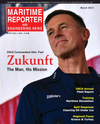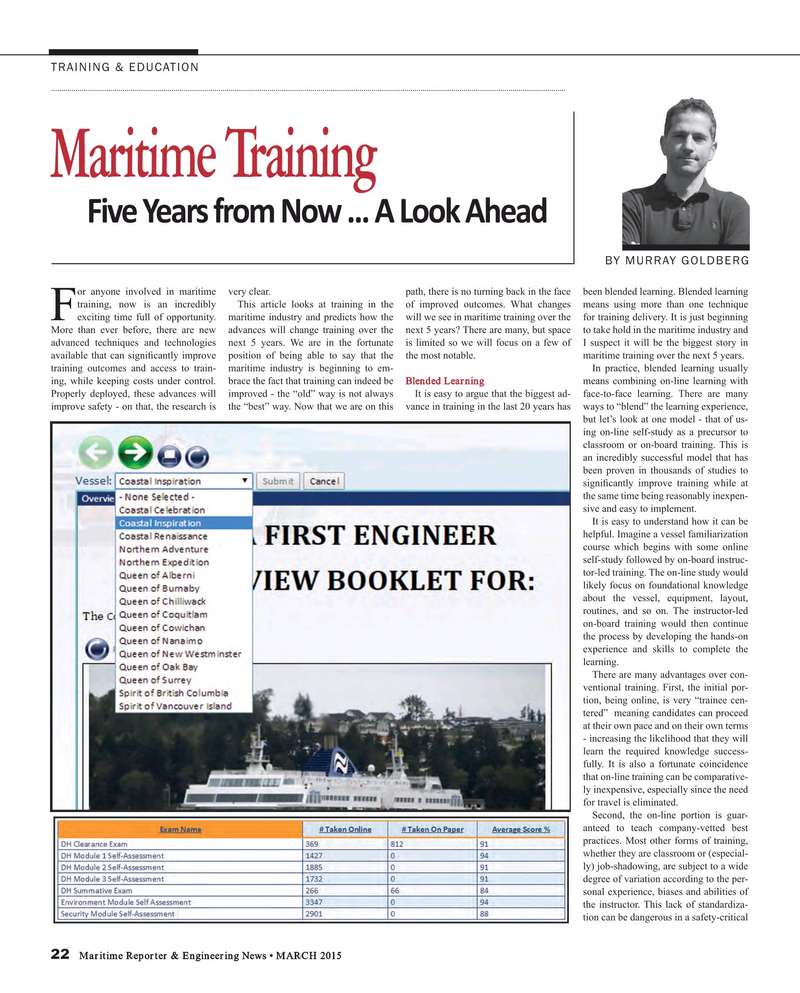
Page 22: of Maritime Reporter Magazine (March 2015)
U.S. Coast Guard Annual
Read this page in Pdf, Flash or Html5 edition of March 2015 Maritime Reporter Magazine
TRAINING & EDUCATION
Maritime Training Five Years from Now ... A Look Ahead
BY MURRAY GOLDBERG or anyone involved in maritime very clear. path, there is no turning back in the face been blended learning. Blended learning training, now is an incredibly This article looks at training in the of improved outcomes. What changes means using more than one technique
Fexciting time full of opportunity. maritime industry and predicts how the will we see in maritime training over the for training delivery. It is just beginning
More than ever before, there are new advances will change training over the next 5 years? There are many, but space to take hold in the maritime industry and advanced techniques and technologies next 5 years. We are in the fortunate is limited so we will focus on a few of I suspect it will be the biggest story in available that can signi? cantly improve position of being able to say that the the most notable. maritime training over the next 5 years. training outcomes and access to train- maritime industry is beginning to em- In practice, blended learning usually ing, while keeping costs under control. brace the fact that training can indeed be Blended Learning means combining on-line learning with
Properly deployed, these advances will improved - the “old” way is not always It is easy to argue that the biggest ad- face-to-face learning. There are many improve safety - on that, the research is the “best” way. Now that we are on this vance in training in the last 20 years has ways to “blend” the learning experience, but let’s look at one model - that of us- ing on-line self-study as a precursor to classroom or on-board training. This is an incredibly successful model that has been proven in thousands of studies to signi? cantly improve training while at the same time being reasonably inexpen- sive and easy to implement.
It is easy to understand how it can be helpful. Imagine a vessel familiarization course which begins with some online self-study followed by on-board instruc- tor-led training. The on-line study would likely focus on foundational knowledge about the vessel, equipment, layout, routines, and so on. The instructor-led on-board training would then continue the process by developing the hands-on experience and skills to complete the learning.
There are many advantages over con- ventional training. First, the initial por- tion, being online, is very “trainee cen- tered” meaning candidates can proceed at their own pace and on their own terms - increasing the likelihood that they will learn the required knowledge success- fully. It is also a fortunate coincidence that on-line training can be comparative- ly inexpensive, especially since the need for travel is eliminated.
Second, the on-line portion is guar- anteed to teach company-vetted best practices. Most other forms of training, whether they are classroom or (especial- ly) job-shadowing, are subject to a wide degree of variation according to the per- sonal experience, biases and abilities of the instructor. This lack of standardiza- tion can be dangerous in a safety-critical 22 Maritime Reporter & Engineering News • MARCH 2015
MR #3 (18-25).indd 22 MR #3 (18-25).indd 22 3/3/2015 9:49:03 AM3/3/2015 9:49:03 AM

 21
21

 23
23
